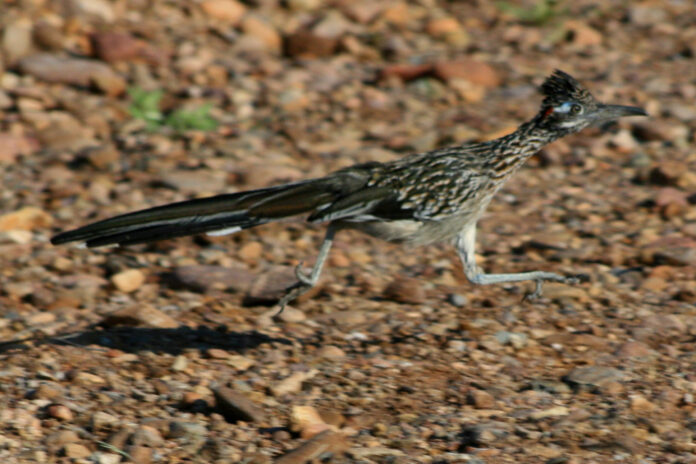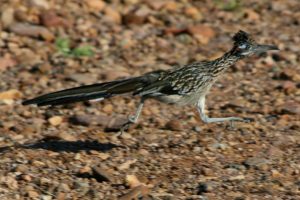
BY HANNES THUM

Encompassing most of Nevada and parts of Utah, Idaho, Oregon and California, the Great Basin is unique in that no water (including the snowmelt that is currently beginning to run off of the mountains) that flows there will ever reach the ocean. Water trickles down the rugged mountainsides into rivulets, creeks, and even rivers—but the most that that water can do is to percolate down into an aquifer or begin to evaporate back into the sky.
The Great Basin is defined, in a sense, by its aridity. Not enough water ends up in the region for the water to have cut and carved a way out—what water does end up there, stays there. It is a region defined also by emptiness, at least as far as human presence is concerned. Highways that transect the region are long and lonely.
It was on one of these long and lonely highways, a hundred miles at least in any direction to any named town, when a roadrunner (Geococcyx californianus) suddenly appeared. I couldn’t help comparing it to the Looney Tunes version from my childhood, and if we hadn’t been traveling at a zippy 75 miles per hour, I would have liked to stop and listen to see if it really said “beep beep.”
Though the way that the sagebrush valleys give way to steep, vertical mountainsides in that part of Nevada is familiar to my Idaho-attuned personal geography, the appearance of this strange Southwestern bird, even for a couple of seconds, reminded me that I was indeed a ways from home.
The landscape we were driving through is marked by so-called basin and range topography—the mountain ranges there run north to south and the spaces between the mountains are broad, flat valleys. This part of the continent has been pulled apart tectonically and faulted (the faults also run north to south along the edges of the ranges) and the mountains went up and the valleys went down. Mountain range, valley, mountain range, valley… and so on for as far as the eye can see to the east and to the west.
The simpler highways run parallel to the mountains, down in the valleys. The more complicated highways cut directly across them.
Juniper trees studded the hillsides that rose to high peaks still covered in deep snow, and the breeze smelled like I was a long ways from the nearest gas station. I was. Alongside the highway, ponds filled by recent spring rainstorms reflected the distant mountains. They would have dried up by now, and by summer the mud beneath them will have cracked in the dry air.
It is an empty place if all you are looking for is the next town on the horizon. But, much like our region of Idaho, a place where there is plenty to see once you start noticing what to look for.
Hannes Thum is a Wood River Valley native and has spent most of his life exploring what our local ecosystems have to offer. He currently teaches science at Sun Valley Community School.


